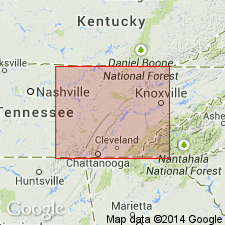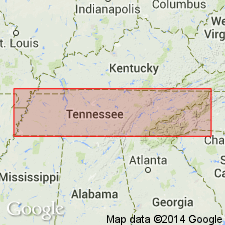
- Usage in publication:
-
- Burnt Mill shale
- Modifications:
-
- Original reference
- Dominant lithology:
-
- Shale
- Coal
- AAPG geologic province:
-
- Appalachian basin
Summary:
Pg. 6, 19, pls. 2, 3, 4. Burnt Mill shale of Crooked Fork group. Includes beds between top of Crossville sandstone and base of Coalfield sandstone (new). Thickness 35 to 130 feet. Hooper coal occurs near base of shale. In northern part of Barthell Southwest quadrangle, overlying Coalfield sandstone is missing and Burnt Mill and Glenmary shale (new) form a single unit; this composite unit in turn is truncated by overlying Wartburg sandstone which locally rests on the Crossville. Age is Early Pennsylvanian (Pottsville).
Named from exposures near Burnt Mill Bridge in Robbins and Oneida South quadrangles, Scott Co., eastern TN.
Source: US geologic names lexicon (USGS Bull. 1200, p. 547).

- Usage in publication:
-
- Burnt Mill Shale
- Modifications:
-
- Areal extent
- AAPG geologic province:
-
- Appalachian basin
Summary:
(East-central sheet; not separately mapped.) Burnt Mill Shale of Crooked Fork Group. Mostly dark-gray to light-brown shale, with minor siltstone. Thin sandstone locally present near base. Hooper coal just above base. Thickness as much as 110 feet. Lies below Coalfield Sandstone and above Crossville Sandstone; both of Crooked Fork Group. Age is Pennsylvanian.
Source: Publication.

- Usage in publication:
-
- Burnt Mill Shale
- Modifications:
-
- Areal extent
- AAPG geologic province:
-
- Appalachian basin
Summary:
Burnt Mill Shale of Crooked Fork Group mapped in Roane and Morgan Cos., eastern TN. Unit consists of silty, dark-gray to olive-black shale, locally interbedded with laminae of sandstone and thin beds of light-gray, very fine grained, medium light-gray, very fine to fine-grained sandstone with shale laminae. Hooper coal and associated dark gray to olive-gray, rooted seat earth occurs locally near base. Thickness ranges from 50 to 100 ft. Overlies Crossville Sandstone and underlies Coalfield Sandstone, both of Crooked Fork Group. Age is Early Pennsylvanian.
Source: GNU records (USGS DDS-6; Reston GNULEX).
For more information, please contact Nancy Stamm, Geologic Names Committee Secretary.
Asterisk (*) indicates published by U.S. Geological Survey authors.
"No current usage" (†) implies that a name has been abandoned or has fallen into disuse. Former usage and, if known, replacement name given in parentheses ( ).
Slash (/) indicates name conflicts with nomenclatural guidelines (CSN, 1933; ACSN, 1961, 1970; NACSN, 1983, 2005, 2021). May be explained within brackets ([ ]).

